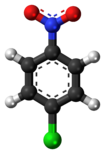4-nitrochlorobenzene
|
|
|||
| Names | |||
|---|---|---|---|
|
Preferred IUPAC name
1-Chloro-4-nitrobenzene
|
|||
| Other names
4-Chloro-1-nitrobenzene
4-Chloronitrobenzene p-Nitrochlorobenzene PNCBO |
|||
| Identifiers | |||
|
3D model (Jmol)
|
|||
| ChemSpider | |||
| ECHA InfoCard | 100.002.554 | ||
| KEGG | |||
|
PubChem CID
|
|||
| UNII | |||
|
|||
|
|||
| Properties | |||
| C6H4ClNO2 | |||
| Molar mass | 157.55 g·mol−1 | ||
| Appearance | Light yellow solid | ||
| Odor | sweet | ||
| Density | 1.52 g/cm3 (20 °C) | ||
| Melting point | 83.6 °C (182.5 °F; 356.8 K) | ||
| Boiling point | 242.0 °C (467.6 °F; 515.1 K) | ||
| Insoluble | |||
| Solubility in other solvents | Soluble in toluene, ether, acetone, hot ethanol | ||
| Vapor pressure | 0.2 mmHg (30°C) | ||
| Hazards | |||
| Safety data sheet | External MSDS | ||
| Flash point | 12 °C (54 °F; 285 K) | ||
| Lethal dose or concentration (LD, LC): | |||
|
LD50 (median dose)
|
812 mg/kg (rat, oral) 1414 mg/kg (mouse, oral) 440 mg/kg (mouse, oral) 420 mg/kg (rat, oral) |
||
|
LC50 (median concentration)
|
164 mg/m3 (cat, 7 hr) | ||
| US health exposure limits (NIOSH): | |||
|
PEL (Permissible)
|
TWA 1 mg/m3 [skin] | ||
|
REL (Recommended)
|
Ca | ||
|
IDLH (Immediate danger)
|
Ca [100 mg/m3] | ||
|
Except where otherwise noted, data are given for materials in their standard state (at 25 °C [77 °F], 100 kPa).
|
|||
|
|
|||
| Infobox references | |||
4-Nitrochlorobenzene is the organic compound with the formula ClC6H4NO2. It is a pale yellow solid. 4-Nitrochlorobenzene is a common intermediate in the production of a number of industrially useful compounds, including common antioxidants found in rubber. Other isomers with the formula ClC6H4NO2 include 2-nitrochlorobenzene and 3-nitrochlorobenzene.
4-Nitrochlorobenzene is prepared industrially by nitration of chlorobenzene:
This reaction affords both the 2- and the 4-nitro derivatives, in about a 1:2 ratio. These isomers are separated by distillation. 4-Nitrochlorobenzene was originally prepared by the nitration of 4-bromochlorobenzene by Holleman and coworkers.
4-Nitrochlorobenzene is an intermediate in the preparation of a variety of derivatives. Nitration gives 2,4-dinitrochlorobenzene, and 3,4-dichloronitrobenzene. Reduction with iron metal gives 4-chloroaniline. The electron-withdrawing nature of the appended nitro-group makes the benzene ring especially susceptible to nucleophilic aromatic substitution, unlike related chlorobenzene. Thus, the strong nucleophiles hydroxide, methoxide, and amide displace chloride to give respectively 4-nitrophenol, 4-nitroanisole, 4-nitroaniline.
...
Wikipedia



